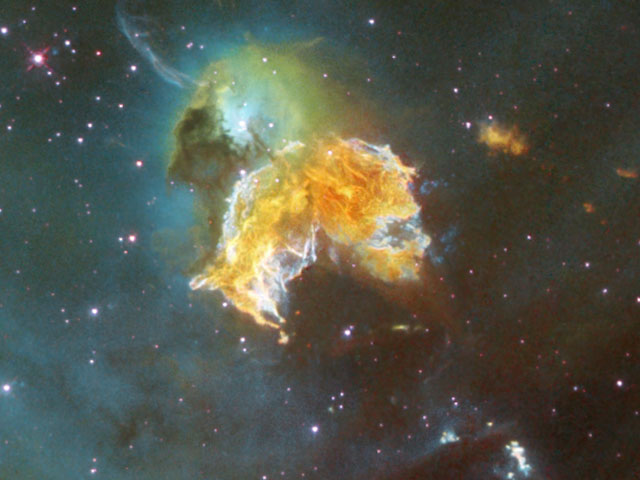Credit & Copyright: Y.-H. Chu & R. M. Williams
(UIUC)
Explanation:
What has this supernova left behind?
As little as 2,000 years ago, light from a massive stellar explosion in the
Large
Magellanic Clouds (LMC) first reached planet Earth.
The LMC is a close galactic neighbor of our
Milky Way Galaxy
and the rampaging
explosion
front is now seen moving out - destroying or displacing
ambient gas clouds while leaving behind relatively dense
knots of gas and dust.
What remains is one of the largest
supernova remnants in the
LMC: N63A.
Many of the surviving dense
knots have been themselves compressed and may further
contract to form new stars.
Some of the resulting stars may then explode in a supernova,
continuing the cycle.
Pictured above is a close-up of one of the largest
remaining knots of dust and gas in
N63A
taken by the orbiting Hubble Space Telescope.
N63A spans over 25
light years and lies about 150,000 light years away
toward the southern
constellation
of Dorado.
1999 2000 2001 2002 2003 2004 2005 2006 2007 2008 2009 2010 2011 2012 2013 2014 2015 2016 2017 2018 2019 2020 2021 2022 2023 2024 2025 |
Январь Февраль Март Апрель Май Июнь Июль Август Сентябрь Октябрь Ноябрь Декабрь |
NASA Web Site Statements, Warnings, and Disclaimers
NASA Official: Jay Norris. Specific rights apply.
A service of: LHEA at NASA / GSFC
& Michigan Tech. U.
|
Публикации с ключевыми словами:
LMC - supernova remnant - БМО - остаток Сверхновой
Публикации со словами: LMC - supernova remnant - БМО - остаток Сверхновой | |
См. также:
Все публикации на ту же тему >> | |
